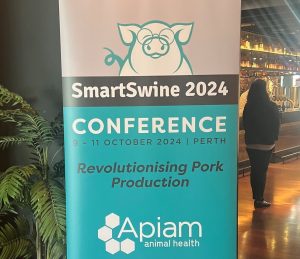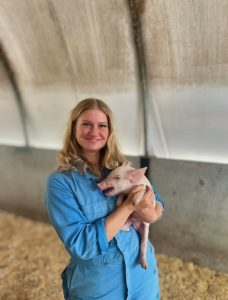This paper presented by Dr Gemma Chuck ay AVAMS 2021 outlines Apiam’s proprietary ProDairy Partnership – a unique consultancy and health platform.
Introduction
The discovery of penicillin by Sir Alexander Fleming in 1928 is arguable the greatest medical discovery of our
age. But as Fleming predicted, previously susceptible bacteria developed drug resistance at an alarming rate. In production animals, a direct correlation of antimicrobial use to antimicrobial resistance at a supranational level has been demonstrated1. The establishment of formalised antimicrobial stewardship programs is critical in providing veterinarians with the necessary knowledge and tools to reduce inappropriate prescribing of these drugs2.
Veterinarians are the guardians of restricted animal medicines and stewards of animal health and welfare. The challenges associated with production animal practice are vastly different from companion animal and equine practice in that the approach has typically been at the herd level as opposed to individual animal level. This can lead to reduced clarity surrounding intended medicine purpose, poorer compliance and accountability in treated herd animals, and inaccurate reporting and benchmarking of overall pharmaceutical use. Additionally, production animals are by definition, any animal that is farmed for food or fibre. This has implications in relation to violative drug residues and potential food safety issues, especially food intended for human consumption.
Many dairy veterinarians will establish therapeutic need for veterinary pharmaceuticals on-farm, but the choice of medicine and frequency of review can be inconsistent between clinicians and veterinary practices. Product choice for any given condition may be based on personal preference of the vet or client, historic and/or recent diagnostic testing with an evidence-based approach, method of administration, pharmacokinetic and pharmacodynamic considerations, historical therapeutic response, clinical experience of the veterinarian or a combination of
these reasons. Whilst the majority of veterinarians strive to promote ‘best practice’ at the farm level, it must be acknowledged that in reality there has been minimal introduction or adoption of standardised methods to obtain objective data to support this practice. The establishment of a bone fide client-vet relationship is widely recognised as a prerequisite to prescribe most scheduled veterinary poisons, however the maintenance of such a relationship is less transparent with the frequency and nature of contact inconsistent between farming enterprises.
The ProDairy Partnership
The ProDairy Partnership is a unique initiative designed to meet the needs of Australian dairy farmers and veterinarians. The partnership is between the dairy client and their local herd veterinarian, with the program’s key objectives to improve cow health, welfare and productivity. There is a focus on preventative health and antimicrobial stewardship with active monitoring of disease status and treatment use within a herd. There are many components of the program. Initial consultations relating to the herd profile, current management and inspection of facilities are essential to establish a good partnership. A comprehensive annual survey, active discussion and series of risk assessments determines the therapeutic requirements in relation to diagnosed disease issues that are occurring in each of the animal groups within the herd. Key activities are entered into a bespoke annual event calendar to allow proactive planning for procedures relating to animal husbandry, reproductive management, milk quality and biosecurity.
A key element of the ProDairy Partnership is the development and provision of tailored animal health treatment protocols and farm-specific agreed therapies as determined by the therapeutic requirements of the herd. The aim of these protocols is to provide transparency on animal health treatments and preventative measures for producers, farm staff, veterinarians, advisors and industry stakeholders.
ProDairy Central
Apiam Animal Health is an extensive business with multiple clinics in the major dairying regions of Australia. There is a current need to establish a more transparent model to provide an evidence-based framework for diagnostics, dispensing and on-farm pharmaceutical use whilst still achieving the flexibility required in dealing with large production animal systems. The changing state of best practice and antimicrobial prescribing guidelines meant that a comprehensive software program was warranted, one which could generate and update protocols and allow comprehensive and relevant reporting.
ProDairy Central is an integrated cloud-based software which has been specifically developed by Apiam Animal Health to address these issues whilst ensuring legislative requirements are met. The application can be accessed by all Apiam veterinarians with assigned bona fide dairy clients. Clients also have access via a single sign-on customer- interface which is also available for farm staff. The customer-interface presents the treatment protocols developed for that herd, along with other resources such as training webinars to view on-demand, a library of 100+ farm factsheets (and advice guides) and farm reports.
Treatment protocols
Via consultation, vets develop customised treatment protocols from established templates which guide and maintain antimicrobial stewardship for a comprehensive range of health conditions in calves, youngstock, adult cows and bulls. The protocols clearly detail medications prescribed, route of administration, dosage and duration of treatment, withholding periods and contraindications, all of which reduces the risk of violative drug residues.
Protocols are created from Standard Templates which can also be modified and saved as Custom Templates for future use. This assists in providing consistent delivery of care for multi- farm enterprises and corporate clients which is an increasing requirement in the dairy industry. Custom Templates allow clinics and regions to redefine their own standards for protocol development where there are genuine reasons supporting variation from the Standard Templates. Some animal health conditions are only present in specified regions of Australia, such as Bovine Ephemeral Fever. A Custom Template of protocols can be created for a herd outside of this region with this protocol being disabled.
Each treatment protocol provides a holistic approach to the health condition with sections on Diagnosis, Treatment, Supportive Care, Future Plan and With-hold Periods. The software allows multiple treatments for multiple cases within the same protocol allowing complete flexibility to suit a diverse range of dairy farming systems. For example, the General Mastitis protocol provides treatment advice for a range of mastitis presentations which factor in the age of the animal, quarter(s) affected and severity of the condition. Likewise, the Endometritis protocol provides visual representation of the different discharge scores with a variety of treatment options for each. Treatment options in all protocols are not confined to antimicrobials. Pain relief and adjunct therapies (both oral and systemic) are also included the protocols to promote best practice and improved animal welfare outcomes.
For each treatment a Preferred Option is selected by default. Veterinarians have the option to use this Preferred Option or to select from a range of available options that best meet the needs of the health issue. To assist with pharmaceutical selection each treatment is accompanied by a Veterinary Guidance section highlighting merits and pitfalls of the available products, along with evidence-based recommendations on best practice antimicrobial stewardship. The Vet Guidance sections support less experienced veterinarians by also providing key discussion points for each health condition, information on industry benchmarks, recommended surveillance and disease monitoring methods and preventative measures. External and internal files and links can be embedded into the Vet Guidance sections to allow referral to existing industry and ProDairy resources.
There is a Notes section for every treatment protocol which allows records such as historical observations, current disease status and response to therapy to be documented. Each note is time logged and provides a complete history of protocol development with any modifications. This assists with communication between veterinarians and provides a better understanding of protocol evolution.
The collective features of this tool lead to in-depth discussions between the dairy client and their veterinarian. This has been invaluable in gaining a deeper understanding of the farming system and predisposing management issues. These visits are purposeful and provide the opportunity to discuss topics that the client may not have been aware
of, or the vet did not previously have time to investigate. Protocols can be viewed on-line and are available to print, hardcopy versions are provided in distinct ProDairy folders for on-farm use. Protocols are reviewed a minimum of twice annually to update and meet the current therapeutic requirements of the herd. The use of veterinary medications is monitored centrally and locally at ProDairy clinics for indication, frequency and level of use. This allows early identification of emerging on-farm issues and reporting on prescription veterinary medicines.
Treatment Indication factsheets
Every treatment protocol is supported by a treatment indication factsheet relating to the specific animal health condition. There are approximately 45 animal health treatment protocols with directly accompanying factsheets as well as an additional 80 factsheets relating to general dairy farm topics. These resources are accessible via the customer- interface on-line library and can be downloaded in pdf format. They are also available in hardcopy for easy reference by all staff on-farm.
Adoption of ‘best practice’ standards of care
At present, the ProDairy Partnership is being implemented on over 250 Australian dairy herds in Victoria, New South Wales, Tasmania and Queensland. The service has resulted in an increase in the use of pain relief medications and preventative health measures such as vaccination programs and use of teat sealants to prevent clinical mastitis
at calving. Best practice standards in animal husbandry procedures such as calf disbudding have also increased, resulting in a direct improvement in animal welfare. There have been notable increases in diagnostic testing and surveillance at the farm and clinic level in the areas of mastitis pathogen identification, colostrum and water cleanliness, failure of passive transfer and bulk milk biosecurity screening. Welfare and biosecurity plans have been encouraged with good uptake, utilising the WelfareCHECK and BioCHECK tools, developed by the Australian Cattle Veterinarians, a special interest group of the Australian Veterinary Association.
Reporting
Comprehensive reporting allows temporal and spatial trends to be identified through the ability to monitor product use within and between clinics, regions and states, and by season and year. All products are categorised by active ingredient(s), biological system, area(s) of use and in the case of antimicrobials, ASTAG rating and antimicrobial class. The customised treatment protocols allow more transparency between products purchased and products used for a given purpose. There are multiple layers of veterinary oversight for the products used on any farm. Our veterinarians have found that the ProDairy Partnership has increased awareness and identification of issues earlier than previously, allowing more timely investigation and better animal health and welfare outcomes.
One of the key objectives of Australia’s National Antimicrobial Resistance Strategy 2020 and Beyond is “Appropriate Usage and Stewardship Practices” 3. The ProDairy Partnership is delivering the priority areas identified in the One Health Master Action Plan 20214 and is leading the way in a providing a formalised AMS initiative in the dairy sector.
References
- Chantziaras I, Boyen F, Callens B, Dewulf J. Correlation between veterinary antimicrobial use and antimicrobial resistance in food-producing animals: a report on seven countries. Journal of antimicrobial chemotherapy 2014;69:827-834.
- Hardefeldt LY, Gilkerson JR, Billman-Jacobe H et al. Barriers to and enablers of implementing antimicrobial stewardship programs in veterinary practices. Journal of veterinary internal medicine 2018;32:1092-1099.
- Australia’s National Antimicrobial Resistance Strategy – 2020 and Beyond. Canberra, 2019.
- One Health Master Action Plan for Australia’s National Antimicrobial Resistance Strategy – 2020 and beyond.
Commonwealth of Australia, Canberra, 2021.









